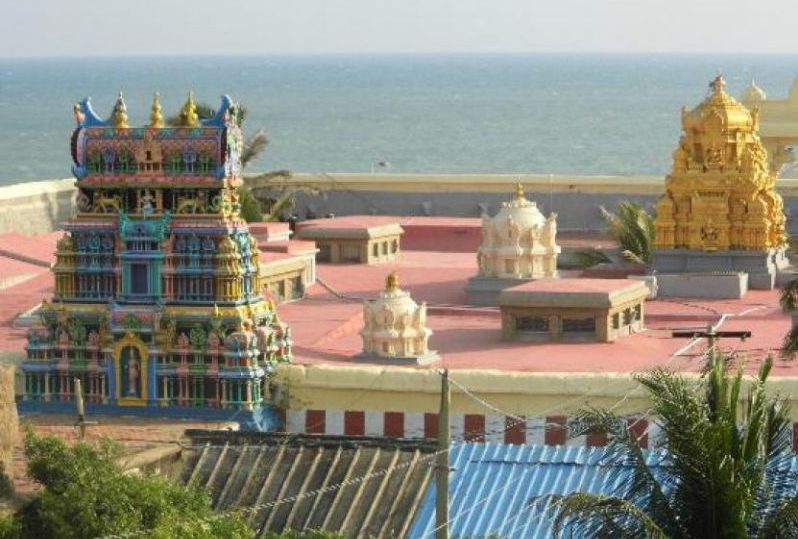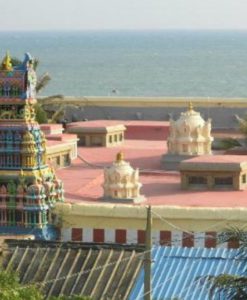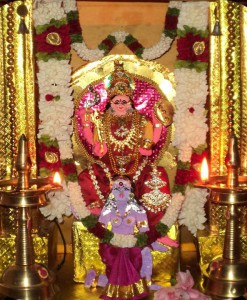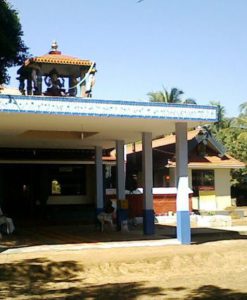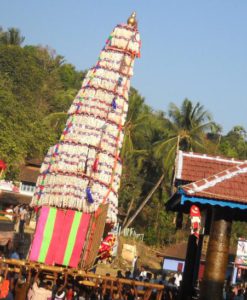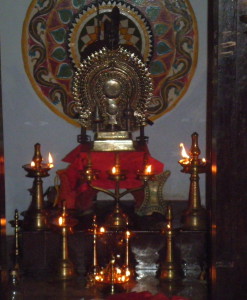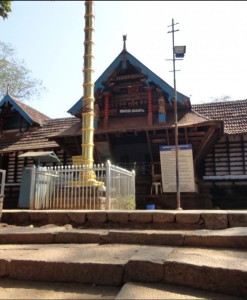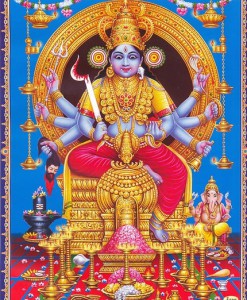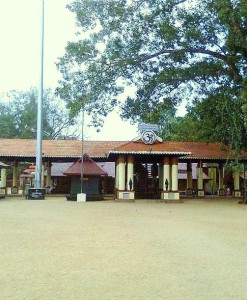No products in the cart.
Kanyakumari Temple | Bhagavathi Amman Temple
Devi Kanyakumari, is Shree Bhagavathy in the form of an adolescent girl child. Devi is also known as Shree Baala Bhadra or Shree Baala. However, she is also worshiped as Shree Bhadrakali by devotees.
Situated on the seashore of Kanyakumari in Tamil Nadu, the southern tip of mainland India, overlooking the sea, this Kanyakumari Temple is dedicated to the virgin Goddess Devi Kanyakumari. The name ‘Kanyakumari’ stands for ‘Kanya’ meaning ‘Virgin’ and ‘Kumari’ meaning Girl.
Kanyakumari and its surroundings are believed to be part of the land which was created by Parasurama, an incarnation of Lord Vishnu. Folktales and mythological stories speak about Kanyakumari.
In mythology, it is full of conflicts between Devas and Asuras, and finally the Devas get victory. It is the conquest of good over evil.
Banasura (Grandson of Mahabahali), the demon king, propitiated Lord Brahma. When Banasura asked for a boon of immortality, Brahma expressed his inability to grant such a boon, but gave an option to choose his own manner of death. Banasura wished that if at all he had to die, let his death be at the hands of a virgin. Brahma granted his boon.
Banasura, with this boon, started to harass the Devas and torturing the saints and rishis. Unable to bear this agony, they appealed to Mother Earth who in turn sought the help of Her consort Lord Vishnu, who is the protector of the Universe.
On the Lord’s command, the Devas propitiated Parasakthi who alone was capable of destroying Banasura. The Devas performed a Yagna which was so powerful that the Goddess was much pleased. She promised to annihilate Banasura. As ordained, Parasakthi in her reincarnation came down to earth as Devi Kumari. It is very common mythological fact that whichever reincarnation she took, she would do penance to rejoin her husband Lord Shiva through marriage.
Hence Kumari did penance so that she would be married to Lord Shiva. Shiva, pleased and happy, expressed his willingness to marry her. This was made known to Kumari. Narada who undertook this task arranged a proper time for marriage before dawn and insisted that the auspicious time should not be missed. Elaborate arrangements were made at Kumari’s place to celebrate the marriage.
The Lord Shiva was staying at Suchindrum. The bridegroom’s party started from Suchindrum well in advance with pomp and pageantry. Meanwhile, Narada was prompted by the Devas to do something to stop the marriage, because once the marriage was over, Kumari could not be a virgin and Banasura could not be killed as he could be killed only by a virgin.
Narada hit upon a plan, and assumed the form of a cock and waited at the place called Vazhukkamparai. When the marriage party reached at that place on their way to Kanyakumari, Narada crowed aloud. On hearing this by Lord Shiva and his party, thought that it was dawn and the auspicious hour had passed. Hence they returned to Suchindrum, greatly disappointed. ( Also see – Suchindram Thanumalayan Temple )
Meanwhile, Devi Kanyakumari, dressed for the marriage occasion in bridal glory was waiting for the arrival of Lord Shiva and his marriage party. As the bridegroom’s party didn’t turn up, the disappointed Bride Kumari vowed to remain a virgin. Also she scattered all the food items kept for marriage, which turned into sand and pebbles resembling rice and other items. The multi coloured sand found in the Kanyakumari sea shore is attributed to this incident.
Banasura, hearing about the beauty of Kumari, and without realizing who she was, wanted to marry her. Kumari bluntly declined his proposal. Banasura decided to win her by force. A fierce battle ensued at Mahadhanapuram (a place 4 km from Kanyakumari) and in the end, the Goddess Kanyakumari used her Chakrayudha (Discus weapon) and slain Banasura.
All the Devas were watching this and were delighted and sang hymns in praise of Devi Kanyakumari. Then Devi resumed her penance and remained a virgin and continues to perform austerities to this day with the hopes that he will one day unite with her.
The worship of Devi Kanya Kumari dates back to the Vedic times. She has been mentioned in Ramayana, Mahabharata, and the Sangam works Manimekalai, Puranaanooru and Narayaṇa (Mahanarayana) Upanishad, a Vaishnava upanishad in the Taittiriya Samhita of Krishna Yajur Veda.
The temple is said to be over 3000 years old. Sage Parashurama is said to have performed the consecration of the temple and the image of Devi Bhagavathy facing the east, made of blue stone, is believed to have been installed by him. The rites and rituals of the temple is organised and classified by following Sankaracharya’s treatise.
As directed by his Guru Sri Ramakrishna Paramahamsa, Swami Vivekananda, came here to seek Devi’s blessing in December 1892, as devi is the goddess of Sanyasa. It is in this location he decided to embark on the Missionary Work to a higher level of action rather than being passive like the usual Sanyasis’.
Swami Brahmananda (1863–1922) and Swami Nirmalananda (1863–1938), another two disciples of Sri Ramakrishna Parama hamsa also worshiped Devi Kanyakumari. In fact, Swami Nirmalananda brought several small girls from many parts of Kerala to worship Bahagavathy in 1935-36 period. To the surprise of all, seven girls later became the members of the first batch of Nuns of the “Sarada Ashrama”, a Hindu Nunnery started later in 1948 in Ottapalam, Palakkad, Kerala by Swami Vishadananda.
The author of ‘Periplus of the Erythraean Sea’ (60-80 A.D.) has written about the prevalence of the propitiation of the deity Kanyakumari in the extreme southern part of India; “There is another place called Comori and a harbour, hither come those men who wish to consecrate themselves for the rest of their lives, and bath and dwell in celibacy and women also do the same; for it is told that a goddess once dwelt here and bathed.”
Kanyakumari was under the rule of the Paravar Kings till the downfall of Pandyas, and later by kings of Travancore under the overall suzerainty of the British until 1947, when India became independent. Travancore joined the independent Indian Union in 1947. Later in the state partition Kanyakumari became part of Tamil Nadu.
The Goddess standing as a young charming girl in her penance, with a rosary in her right hand is believed to be the one who removes the rigidity of our mind. Devotees usually feel the tears in their eyes or even inside their mind when they pray to the goddess in devotion and contemplation.
Nose ring of Devi Kanyakumari
She wears a sparkling nose jewel sheds lustrous radiance. The nose ring of Devi Kanyakumari is set with rubies. They are so bright and that it could be seen even from the far at night. Also it is told that some ships sailing in the sea, mistaking the brightness of the rubies as the light from the Lighthouse, got wrecked, hitting against the rocks nearby. Due to this reason, the eastern side gate of the Kumari Amman Temple is kept closed.
Devi Kanyakumari Temple as a Shakti Peeth
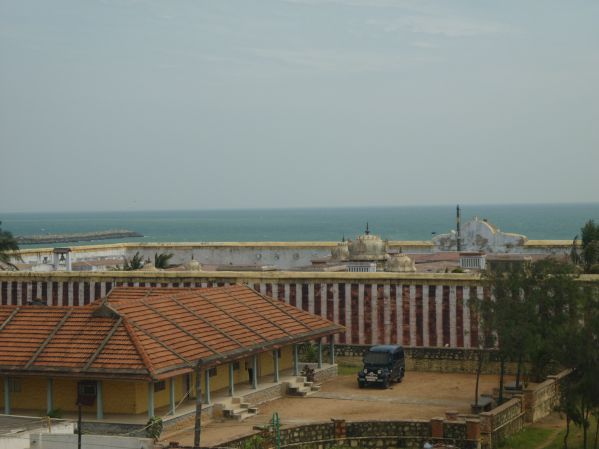
Kanyakumari Temple is regarded as one of the 51 Shakti peethas. The mythological story of Daksha yaga is considered to be the origin story of Shakti Peethas.
Shakti Peetha means the peetha (abode) of Shakti (The divine place enshrined by Mother Goddess), due to the falling of body parts of the corpse of Sati Devi, when Lord Shiva carried it in sorrow. There are 51 Shakti Peeth linking to the 51 alphabets in Sanskrit and the fact that the corpse of Goddess Sati was scattered into 51 parts throughout the Indian subcontinent. The goddess’s back is said to have fallen in Kanyakumari. The Kalabhairava of the temple is called Nimish and the Shakti is addressed as Sarvani.
The pujas in the Devi Kanyakumari Temple are carried out according to the Tanthrasamuchayam like the temples in Kerala. Even though the temple is situated in Tamil Nadu, the Kanyakumari Temple is considered as a Kerala temple since it was once part of the erstwhile Travancore kingdom. Like most of the Bhagavathy temples in Kerala the shrine is opened in the Western door. The priests are still chosen from Kerala Brahmin families and they still adhere to the Kerala type of five pujas per day.
The mantra for worship is :
“Amme Narayanaa! Devi Narayanaa! Lakshmi Narayanaa! Bhadre Narayanaa!”
‘अम्मे नारायणा! देवी नारायणा! लक्ष्मी नारायणा! भद्रऎ नारायणा!’
The devotees offer New Red Sarees, and Ghee wick lamps to the Goddess. Reciting Lalita Sahasranama while approaching and circumambulating the temple is considered auspicious. The location Kanyakumari, i.e. southern tip of India has been held sacred by Hindus’ as it is the confluence of three seas. Pitr Tarpan and taking bath in the sea is done in the Kanyanumari beach as it the convergence of many important theerthas. There are a total of 11 theerthams associated with the temple in the ocean surrounding Kanyakumari.
Kanyakumari Temple Timings
The temple is opened for Darshan –
Morning: 6.00 A.M. to 11.00 A.M.
Evening: 4.00 P.M. to 8.00 P.M.
Festivals at the Kanyakumari Temple
Chitra Pournima Festival
Full moon day in May
Navaratri
A 9 day festival in the month of September–October. The music artists perform their artistic skill to the Devi at the Navarathri Mandapam. An image of the deity is worshipped at the Navarathri Mandapam throughout the duration of Navarathri. Processions are carried on each of the nine Navarathri nights. On the 10th day of the Navarathri, called as the Vijaya Dasami, the destruction of Banasura is celebrated. An image of the deity mount on a silver horse is taken in procession to Mahadhanapuram, the place where Banasura was slain.
Vaisakha festival
10 day festival celebrated in the Tamil Month of Vaikasi (May–June). During this festival, the image of Devi is taken around the town in procession, both in the morning and evening. During Aaraatu, the eastern door is opened. On the ninth day, the Thoni Ezhunellathu takes place, in which Devi will be taken round the water on the western part in a boat.
Kalabham festival
This festival is in the Tamil month of Aadi (Karkkidakam) which comes in July – August. The idol is covered with Sandal paste on the last Friday of the Tamil month (Aadi).
The Kanyakumari Temple which stands in eternal vigil protecting the country, is surrounded by a stone wall and stands on the edge of the ocean. The entrance to the temple is through the northern gate, while the eastern gate always remains closed except on some festival days, when deity is taken out for the ceremonial bath. Every year people from all over the world come to visit this famous temple. Tourists can reach Devi Kanyakumari Temple easily as it is easily accessible by road. Tourists can take auto rickshaws or taxi to the temple. There are also city buses that one can take to reach here.
This temple is at a distance of 1 km away from Kanyakumari Bus Stop as well as quite close to the Kanyakumari Railway Station which is also around 1 km away.
Position of the Kanyakumari Temple
The entrance to the Kanyakumari Temple is through the northern gate, while the eastern gate always remains closed except on some festivals, when the deity is taken out for the ceremonial bath. The eastern door is opened also on new moon days in the months of Edavam, Karkkidakam (Capricorn and Cancer), during Navaratri and in the month of Vrischikam.
After walking around the outer corridor and crossing the Navaratri Mandapam, the pathway leads to the second corridor encircling the shrine. At the entrance here, is the Kala Bhairava Shrine (Kalabhairava is the ferrous form of Lord Shiva who annihilates everything) and the well known as “Patal Ganga Teerth” which provides water for the Devi’s Abhisegham. After this is the Dhwajastambha (flag mast). From here one can have a clear view of the Devi before going in front of the sanctum sanctorum.
Kanyakumari Devi Temple, Bhagavthy Amman Temple

